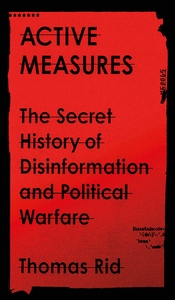Disinformation and Political Warfare: Historical and Technological Insights (A Conversation with Thomas Rid)


Speaker: Dr. Thomas Rid (Johns Hopkins University School of Advanced International Studies)
Date: 11 February 2021
Speaker Session Summary
SMA hosted a speaker session, presented by Dr. Thomas Rid (Johns Hopkins School of Advanced International Studies) as a part of its SMA IIJO Speaker Series.
Dr. Rid began by stating that that there is currently a lack of understanding of how historical influence operations have contributed to the evolution of present day countries’ information operations. He argued that scholars cannot fully grasp 21st century cyber operations without understanding intelligence operations from the 20th century. He stated that his research showed that the exposure of information has developed asymmetrical features for the US and its adversaries, including how influence operations are technically carried out, how operators form their strategies, the ethical constraints faced by operators, and the evaluation of a message’s success.
Next, Dr. Rid began describing two Cold War influence operations. The first was an influence campaign carried out by the CIA in Eastern Berlin, which was designed to increase the appeal of US culture by using balloon drops, the distribution of pro-US leaflets, the use of radio spots, and the publication of magazines. Dr. Rid highlighted two magazines, a women’s magazine and a jazz magazine, both of which were designed to spread the US’s cultural appeal. He then commented that at this time in history, the CIA was effective at targeting fissures in the Soviet Union’s society.
The KGB’s response to the CIA’s influence campaign was to enlist Werner Braunig, a singer and song writer, to write a satirical song aimed at the US’s Strategic Air command. Braunig wrote his song, “The Flying Psychoneurosis,” to ultimately inform the CIA that the KGB was aware of the CIA’s influence operations. However, Dr. Rid pointed out that by partially exposing the CIA’s influence campaign, the KGB lost the ability to completely embarrass the CIA. The KGB lost this ability because once the rumor and assumption that the CIA was carrying out an influence campaign were present at a low level throughout East Germany’s population, this accusation lost its novelty. Dr. Rid then stated that among the outcomes of the CIA’s influence campaign in Eastern Germany was the KGB’s motivation to grow its own influence capabilities. The KGB’s new capabilities were evident when the Soviet Union distributed pamphlets that demonstrated the systemic racism and abuse of minorities in the US in sixteen politically neutral African countries.
Dr. Rid then presented his second example of a Cold War influence campaign. This example focused on the KGB’s release of stolen classified documents (that turned out to be forgeries) to newspapers—first in Norway, then in Germany. To increase the exposure and impact of the leaked information, the KGB forged a document that stated that the US Department of Defense had approved the use of low grade nuclear weapons in combat, which was then published in the Soviet sympathetic Stern magazine. In response, Der Spiegel, Stern‘s main competitor, ran stories exposing the KGB’s use of false information. The KGB used this exposure and dialogue to continue to release information, knowing that both magazines would publish it and create dialogue surrounding the information. Dr. Rid pointed out that this dialogue ultimately legitimized the false and sensational information. The KGB purposefully chose magazines as an outlet for information leaks, Dr. Rid explained, because magazines normally follow weaker journalistic standards and more easily allow information to gain mass circulation.
Dr. Rid concluded his presentation by stating that the strategies the CIA and the KGB used in their war of information still apply to influence operations today. However, new technology has increased the speed at which false information can be spread and countered. He argued that by 2013, the US had become adept at carrying out exposure operations, which could be seen through a trend of news sources exposing leaked or false information. The increasing number of instances relating to false information has led US companies and governments to become effective at creating accurate attribution reports for information. Dr. Rid believes that modern-day Russia does not have this same capability, which is partly because Russia has been focused on creating creating false information and undermining populations’ trust in western institutions.
Speaker Session Recording
Please email Ms. Nicole Omundson (nomundson@nsiteam.com) for access to a recording of this session.
Download Briefing Materials
Dr. Thomas Rid is Professor of Strategic Studies at Johns Hopkins University’s School of Advanced International Studies. Rid brings to Johns Hopkins more than a decade of experience in international security and intelligence studies, previously serving as a Professor of Security Studies in the Department of War Studies at King’s College London, where he developed a Cyber Security module that bridged the gap between technological and political debates. Author of multiple influential books and papers, Dr. Rid has recently shared his expertise on information security through testimony before the U.S. Senate Select Committee on Intelligence, as well as insights on intelligence with the German Bundestag and the UK Parliament. Dr. Rid closely tracked the election interference in 2016 and was one of the first named sources to call out the hack-and-leak as a Russian intelligence operation, only one day after details became public. He has held positions at the RAND Corporation in Washington, the Institut Français des Relations Internationales in Paris, and served as a visiting scholar at Hebrew University and Shalem Center in Jerusalem. From 2007 to 2008, Rid served as a Visiting Scholar at the Center for Transatlantic Relations at Johns Hopkins SAIS. He holds a PhD and MA in Social Science from Humboldt University in Berlin.
